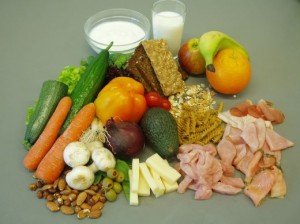>
Proteins are important for the amino acids they contain. Amino acids were at one time considered the building blocks of health. There are about 20 diverse amino acids, the presence of eight of them is vital and should be part of our diet. These are termed as the essential amino acids. The considered disadvantage of plant protein as opposed to animal protein is that it may not hold all the vital amino acids in the required proportions. However, a diverse vegetarian diet implies that a combination of proteins should be consumed, so that the amino acids in one protein recompense for the shortage of another.
Proteins and Amino acids
In essence, proteins are extremely intricate molecules consisting of connected amino acids. Amino acids are simple compounds containing carbon, hydrogen, oxygen, nitrogen and sporadically, sulphur. Proteins are broken down into their basic amino acids during the process of digestion which are then immersed and used to make fresh proteins in the body. A couple of amino acids can be manufactured by the human body. However, the essential amino acids cannot be produced and must be completed through the diet. The eight essential amino acids required by humans are: Leucine, Isoleucine, Valine, Threonine, Methionine, Phenylalanine, Tryptophan, and Lysine. For children, Histidine is also considered to be an essential amino acid.
Proteins are vital for growth and repair. They play a critical role in every biological process of the body. All enzymes are proteins which are very important for the body’s metabolism. The body makes use of carbohydrates and fats for energy but when there is surplus dietary protein or insufficient dietary fat and carbohydrate, protein is utilized.
Most foods include a good quantity of protein; quality source of protein for vegans consist of nuts and seeds, pulses, soya products, cereals and a few dairy products. Special foods contain special proteins, each with their own exclusive amino acid ratio. The size of essential amino acids in foods may fluctuate from the size required by the body to create proteins. Dietary proteins comprising of each essential amino acids in the size that is vital for the body are termed as high quality protein.
Protein quality is dependent on the amino acid model of egg protein, which is believed to be the perfect source. Animal proteins, such as meat, milk and cheese have a propensity to be of a superior protein quality than plant proteins, which is why plant proteins are at times termed as low quality proteins. It is a fact that various plant proteins are deficient in one of the essential amino acids. For example, grains are short of Lysine; pulses have a deficiency of Methionine. This does not mean that vegetarians or vegans have an inadequate supply of essential amino acids. Merging plant proteins, such as a grain with a pulse, makes a high quality protein which is just as good a protein, in fact better than the protein from animal foods. Soya is a high quality protein which is equivalent to meat protein.

Protein Complementing
The limiting amino acid is not similar in dissimilar proteins. This implies that when two dissimilar foods are joined, the amino acids in one protein can reimburse for the one absent in the other. This is recognized as protein complementing. Vegetarians and vegans consuming a balanced diet comprising of grains, pulses, seeds, nuts and vegetables will be having an intake of a blend of proteins that balance one another without necessitating any scheduling. Beans on toast, peanut butter sandwich, muesli with milk, and rice with peas or beans are all ordinary examples of protein complementing.
Formerly, protein complementing was considered necessary to take place within a particular meal. However, this is no more essential as recent study suggests that the body maintains a short-term stock of the essential amino acids. A proportionate vegetarian or vegan diet will simply provide all the protein and essential amino acids required by the body.
Sources and Amount of Proteins
The following table outlined the amount of protein in every source of protein. The chart can help in mapping out a high protein diet.
Sources of protein (single servings)
Good sources
Chick peas (200g or 7oz) 16.0g
Baked beans (225g or 8oz) 11.5g
Tofu (140g or 5oz) 10.3g
Cow’s milk (½ pint) 9.2g
Lentils (120g or 4¼oz) 9.1g
Soya milk (½ pint) 8.2g
Muesli (60g or 2¼oz) 7.7g
Egg, boiled 7.5g
Peanuts (30g or 1oz) 7.3g
Bread, (2 slices) 7.0g
Hard cheese (30g or 1oz) 6.8g
Fair Sources
Brown rice (200g or 7oz)
Broccoli (100g or 3½oz)
Potatoes (200g or 7oz)
Porridge [water] (160g or 6oz)
Poor sources
1 Carrot 0.4g
1 Apple 0.3g
Cream, double (20g or 2/3oz) 0.3g
Butter/margarine None
Vegetable oil None
Sugar or syrup None
Tags: Amino acids, Protein Diet
This entry was posted
on Saturday, May 1st, 2010 at 6:22 pm and is filed under NUTRITION.
You can follow any responses to this entry through the RSS 2.0 feed.
You can leave a response, or trackback from your own site.

